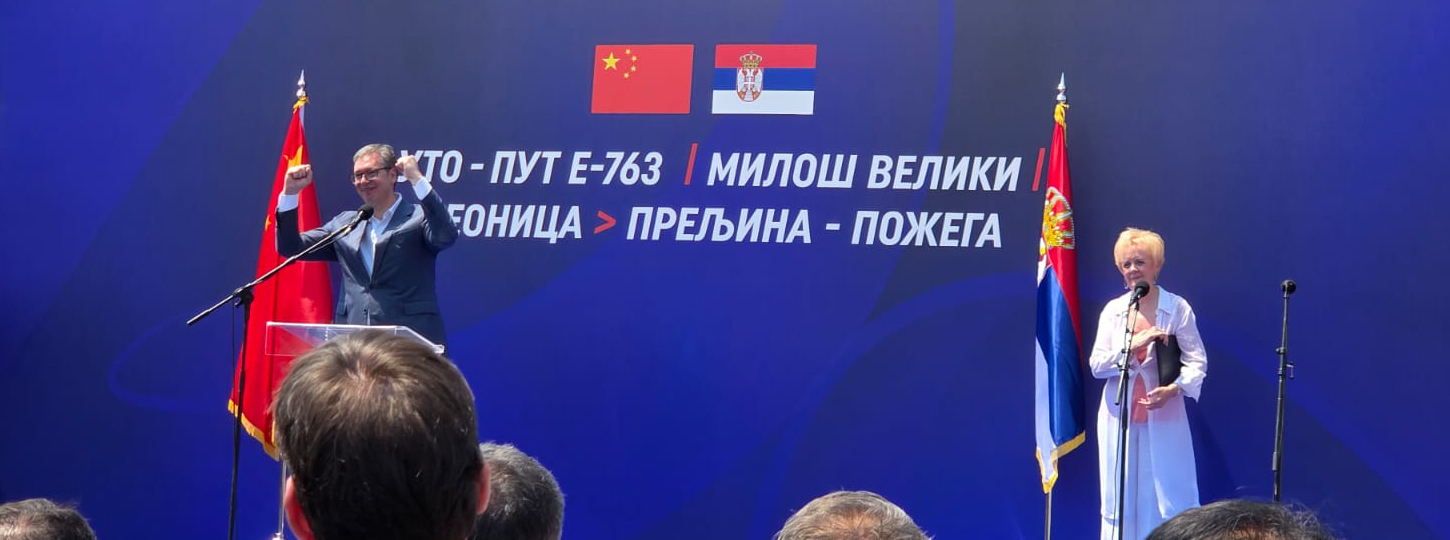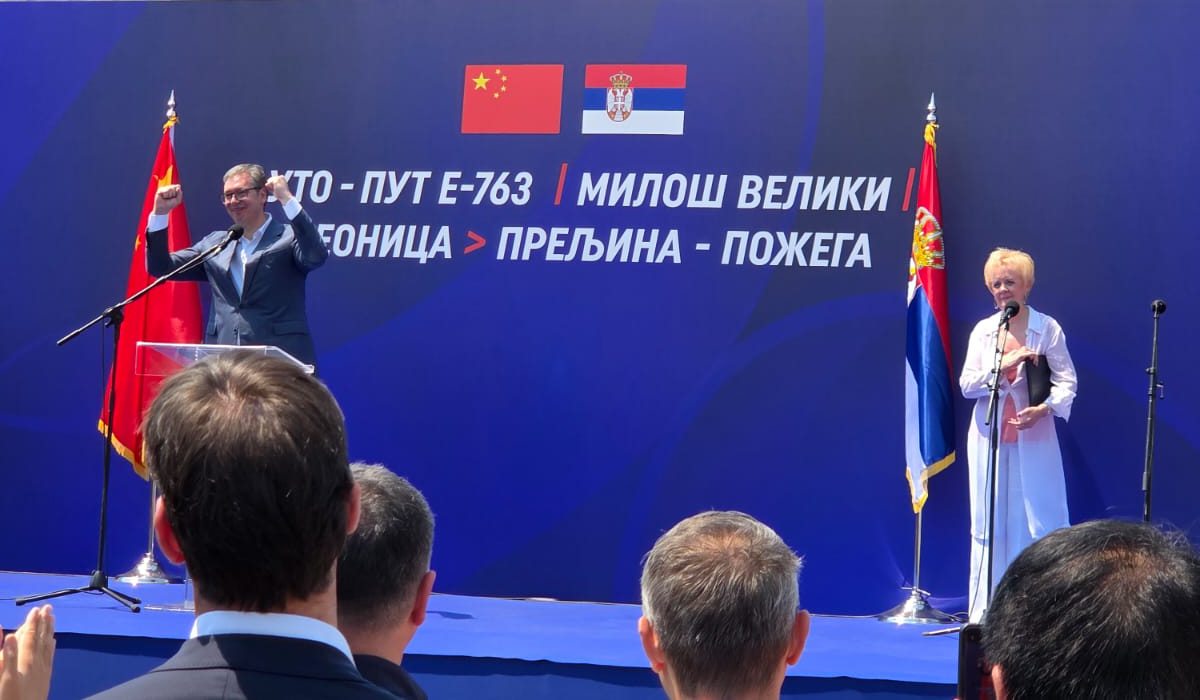Yesterday, on July, 7th, 2025, in the presence of the President of the Republic of Serbia Aleksandar Vučić, Ambassador of the Republic of China to Serbia Li Ming, Minister of Construction, Transport and Infrastructure Aleksandra Sofronijević, Minister of Public Investments Darko Glišić, Acting Director of “Roads of Serbia” and “Corridors of Serbia”, Zoran Drobnjak and Aleksandar Antić, General Director of the company "CRBC" Wang Lijun, representatives of contractors and subcontractors, as well as local governments, the ceremony was held open section of highway E-763 Miloš Veliki, Preljina - Požega.
The Preljina - Požega section, 30.96 km long, is connected to the already built "Miloš Veliki" highway, which is in traffic from Surčin to Preljina, in the full profile of the highway with associated facilities, interchanges, tunnels and bridges.
This section is characterized by the fact that it passes through very difficult geographical terrain, which is why numerous tunnels and bridges were built (almost 1/3 of the route consists of bridges and tunnels).
Topographical and geomorphological conditions necessitated the design and construction of a total of three tunnels: Trbušani, Laz and Munjino Brdo.
The Trbušani tunnel is located in the first third of the section.
Further on, the route crosses the Western Morava and climbs the slopes of the Ovčar and Jelica mountains. The Laz tunnel cuts through the Jelica mountain.
Then the route descends towards Lucani through Markovica and Negrisore.
After Lucan, it passes through the mountain massif through the Munjino Brdo tunnel to Prilipac, where the section ends.
All three tunnels were designed with two separate tunnel tubes, each for one traffic direction.
The length of the tunnel tubes of the Trbušani tunnel is approximately 300 m. The lengths of the tunnel tubes of the Laz tunnel are approximately 2,700 m and 2,900 m (the length of the left tube along the axis of the left tube is 2,842.57 m, and the length of the right tube is 2,662.33 m). The axial distance of the tunnel tubes is from a minimum of 35 m to a maximum of 55 m.
On a third of the length of the tunnel, connecting corridors have been designed for the passage of vehicles from one tunnel tube to another with niches for vehicles in breakdown, as well as 9 pedestrian transverse connecting corridors at prescribed distances, which enable safe evacuation in incident situations.
In the middle part of this transverse corridor for the passage of vehicles, a space is reserved for the power substation. Under the footpaths on both sides of the road, there is space for the accommodation of various electrical and telecommunications installations.
Cross pedestrian crossings for crossing pedestrians from one tube to another in the event of an emergency in the tunnel, are designed to allow emergency vehicles to pass and are located at a distance of 220-280m.
For each tunnel tube, two extensions were designed for the removal of broken down vehicles - Accident niches.
Cross passageways for passing vehicles from one tube to another are part of the Munjino Brdo tunnel, designed at a distance of 1000 to 1006 m in the longitudinal direction.
The Laz and Munjino Brdo tunnels are currently the longest road tunnels in Serbia.
Tunnels are critical facilities from the aspect of the safety of road users, and their importance is reflected in the potential consequences and scale of extraordinary events that can occur in them.
All tunnels on IA state roads have built-in smart lighting systems, changeable traffic signals and video surveillance, while those longer than 500 meters have all the necessary security systems for reporting and detecting fires, air quality control system, tunnel ventilation and smoke extraction, fire hydrant network, public address system for transmitting messages to users, SOS phones, FE devices.
The supervision and management of facilities is carried out 24 hours a day from operational control centers according to clearly defined emergency response procedures.
The extraordinary events themselves, including traffic accidents, can have far greater consequences in the tunnel and the tunnel's influential zone compared to the open section, both due to the specifics of the space and due to the inadequate reactions of road users due to the additional creation of panic due to the limited and closed space.
It is important to emphasize that speed is the main cause of critical events in tunnels and that the speed of movement of vehicles in tunnels is recorded.
The speed limit when driving through tunnels is 80 km/h, and by respecting the speed limit, we raise the level of traffic safety in the tunnel.
A high number of incident events, as well as a large number of recorded inadequate reactions of road users, indicated the need to implement educational campaigns with the aim of raising the level of traffic safety on state roads through the education of drivers and all road users, namely:
- Driver education for safe behavior in tunnels under regular traffic conditions "SAFELY THROUGH THE TUNNEL"
- Driver education for safe behavior in tunnels in the event of emergency events that may endanger the lives of road users "WE ARE NOT ALONE IN THE TUNNEL"
In the entire project, 35 bridges with a total length of 5,196 m, 4 overpasses with a total length of 592 m were designed (3 bridges on local roads after descending from leveled intersections (total length 180m), as well as 4 overpasses within leveled intersections (total length 1,075m) namely:
- 13 bridges are over 100 m long, and the longest bridge 478 m,
- 6 bridges with a length of 25-100 m,
- 16 single-span bridges with a length of 10-25 m
The bridge over the Zapadna Morava is unique compared to the others, because it bridges the river with a span of 80 m, and its total length is 330 m.
1,912,000 m3 of embankment and three complete interchanges were built, which will enable the existing ring road around Čačak to be relieved.
Only in the first part of the section from the existing toll plaza Preljina to Pakovraće, which is 14.3 km long, electricity, telecommunications, water and gas installations were moved to a total of 73 places.
SIGNIFICANCE OF THE PROJECT:
Highway E-763 Belgrade - South Adriatic serves as a vital link between Serbia and Montenegro, connecting Belgrade with the area of the South Adriatic.
On a broader level, it will improve connectivity between Romania, Serbia, Montenegro and Italy.
In Požega, the construction of a traffic junction is planned, along which part of the highway separates for Kotroman and the border crossing with Bosnia and Herzegovina.
The project of the section Preljina - Požega of the E-763 highway is located on the southern part of the E-763 highway in Serbia.
It is a divided highway with a total of four lanes and a design speed of up to 120 km/h.
The project was recognized as the most challenging section for construction on the entire E-763 highway.
You can download the link with the statements and the cover here: 05.07.2025. OPENING CEREMONY OF THE SECTION OF HIGHWAY TO POŽEGA








